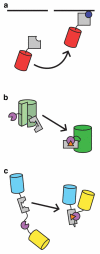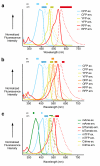Multiplexed visualization of dynamic signaling networks using genetically encoded fluorescent protein-based biosensors
- PMID: 23138230
- PMCID: PMC3584185
- DOI: 10.1007/s00424-012-1175-y
Multiplexed visualization of dynamic signaling networks using genetically encoded fluorescent protein-based biosensors
Abstract
Cells rely on a complex, interconnected network of signaling pathways to sense and interpret changes in their extracellular environment. The development of genetically encoded fluorescent protein (FP)-based biosensors has made it possible for researchers to directly observe and characterize the spatiotemporal dynamics of these intracellular signaling pathways in living cells. However, detailed information regarding the precise temporal and spatial relationships between intersecting pathways is often lost when individual signaling events are monitored in isolation. As the development of biosensor technology continues to advance, it is becoming increasingly feasible to image multiple FP-based biosensors concurrently, permitting greater insights into the intricate coordination of intracellular signaling networks by enabling parallel monitoring of distinct signaling events within the same cell. In this review, we discuss several strategies for multiplexed imaging of FP-based biosensors, while also underscoring some of the challenges associated with these techniques and highlighting additional avenues that could lead to further improvements in parallel monitoring of intracellular signaling events.
Figures



Similar articles
-
Reporting from the field: genetically encoded fluorescent reporters uncover signaling dynamics in living biological systems.Annu Rev Biochem. 2011;80:375-401. doi: 10.1146/annurev-biochem-060409-093259. Annu Rev Biochem. 2011. PMID: 21495849 Free PMC article. Review.
-
Genetically encoded fluorescent biosensors illuminate kinase signaling in cancer.J Biol Chem. 2019 Oct 4;294(40):14814-14822. doi: 10.1074/jbc.REV119.006177. Epub 2019 Aug 21. J Biol Chem. 2019. PMID: 31434714 Free PMC article. Review.
-
Genetically encoded molecular probes to visualize and perturb signaling dynamics in living biological systems.J Cell Sci. 2014 Mar 15;127(Pt 6):1151-60. doi: 10.1242/jcs.099994. J Cell Sci. 2014. PMID: 24634506 Free PMC article. Review.
-
Temporal Metabolite, Ion, and Enzyme Activity Profiling Using Fluorescence Microscopy and Genetically Encoded Biosensors.Methods Mol Biol. 2019;1978:343-353. doi: 10.1007/978-1-4939-9236-2_21. Methods Mol Biol. 2019. PMID: 31119673 Free PMC article.
-
Booster, a Red-Shifted Genetically Encoded Förster Resonance Energy Transfer (FRET) Biosensor Compatible with Cyan Fluorescent Protein/Yellow Fluorescent Protein-Based FRET Biosensors and Blue Light-Responsive Optogenetic Tools.ACS Sens. 2020 Mar 27;5(3):719-730. doi: 10.1021/acssensors.9b01941. Epub 2020 Feb 26. ACS Sens. 2020. PMID: 32101394
Cited by
-
Single-fluorophore biosensors for sensitive and multiplexed detection of signalling activities.Nat Cell Biol. 2018 Oct;20(10):1215-1225. doi: 10.1038/s41556-018-0200-6. Epub 2018 Sep 24. Nat Cell Biol. 2018. PMID: 30250062 Free PMC article.
-
Genetically Encoded Fluorescent Biosensors Illuminate the Spatiotemporal Regulation of Signaling Networks.Chem Rev. 2018 Dec 26;118(24):11707-11794. doi: 10.1021/acs.chemrev.8b00333. Epub 2018 Dec 14. Chem Rev. 2018. PMID: 30550275 Free PMC article. Review.
-
A Co-Culture-Based Multiparametric Imaging Technique to Dissect Local H2O2 Signals with Targeted HyPer7.Biosensors (Basel). 2021 Sep 14;11(9):338. doi: 10.3390/bios11090338. Biosensors (Basel). 2021. PMID: 34562927 Free PMC article.
-
Retrograde labeling, transduction, and genetic targeting allow cellular analysis of corticospinal motor neurons: implications in health and disease.Front Neuroanat. 2014 Mar 26;8:16. doi: 10.3389/fnana.2014.00016. eCollection 2014. Front Neuroanat. 2014. PMID: 24723858 Free PMC article. Review.
-
Single-color, ratiometric biosensors for detecting signaling activities in live cells.Elife. 2018 Jul 3;7:e35458. doi: 10.7554/eLife.35458. Elife. 2018. PMID: 29968564 Free PMC article.
References
-
- Ai HW, Hazelwood KL, Davidson MW, Campbell RE. Fluorescent protein FRET pairs for ratiometric imaging of dual biosensors. Nat Methods. 2008;5:401–403. - PubMed
-
- Ananthanarayanan B, Fosbrink M, Rahdar M, Zhang J. Live-cell molecular analysis of Akt activation reveals roles for activation loop phosphorylation. J Biol Chem. 2007;282:36634–36641. - PubMed
Publication types
MeSH terms
Substances
Grants and funding
LinkOut - more resources
Full Text Sources
Other Literature Sources
Research Materials

